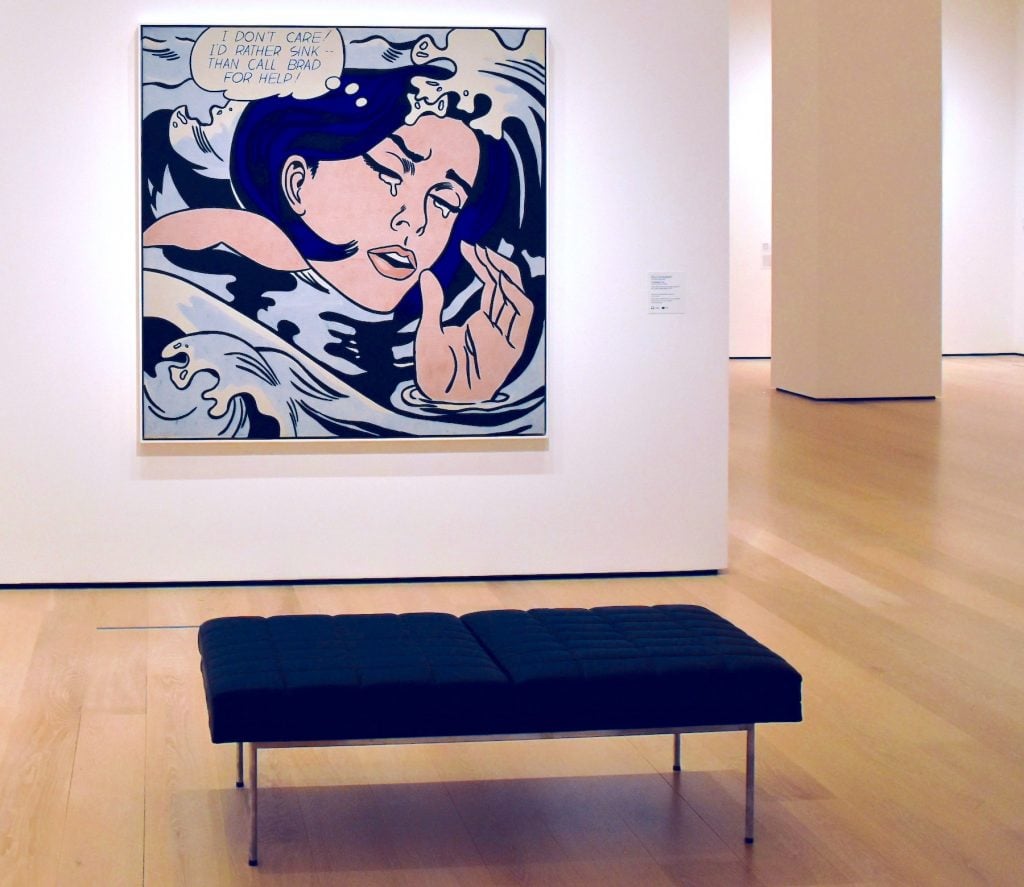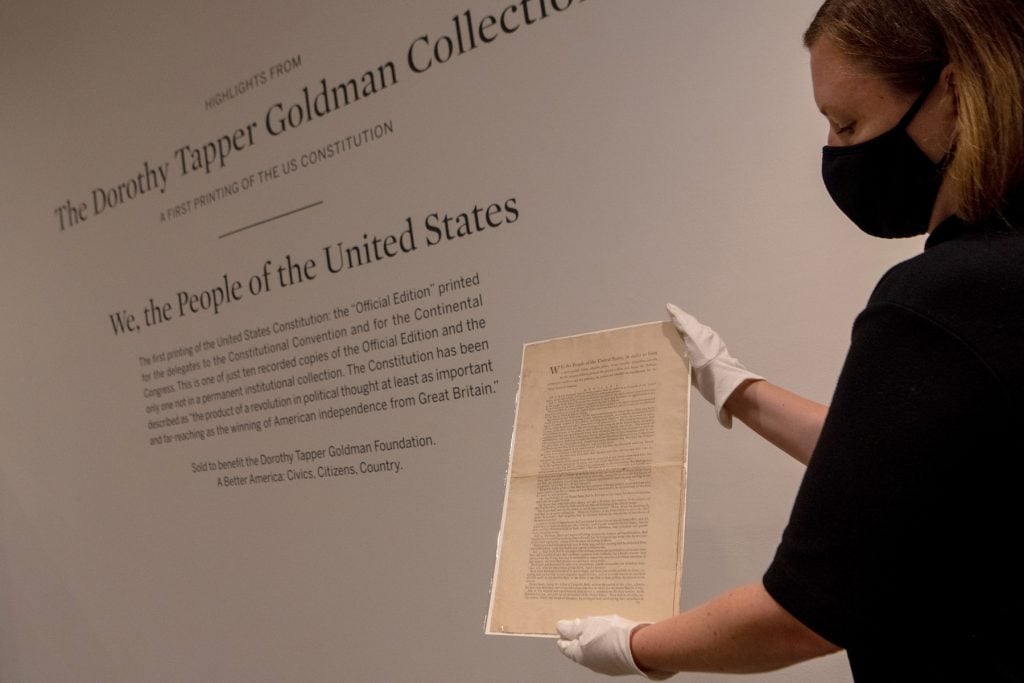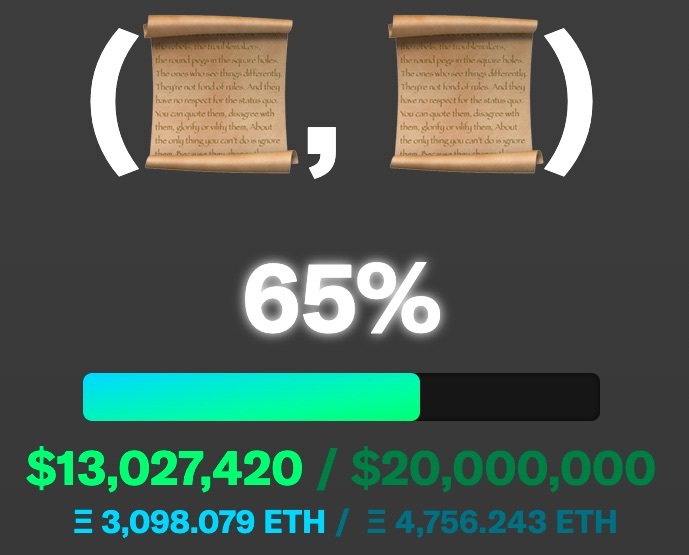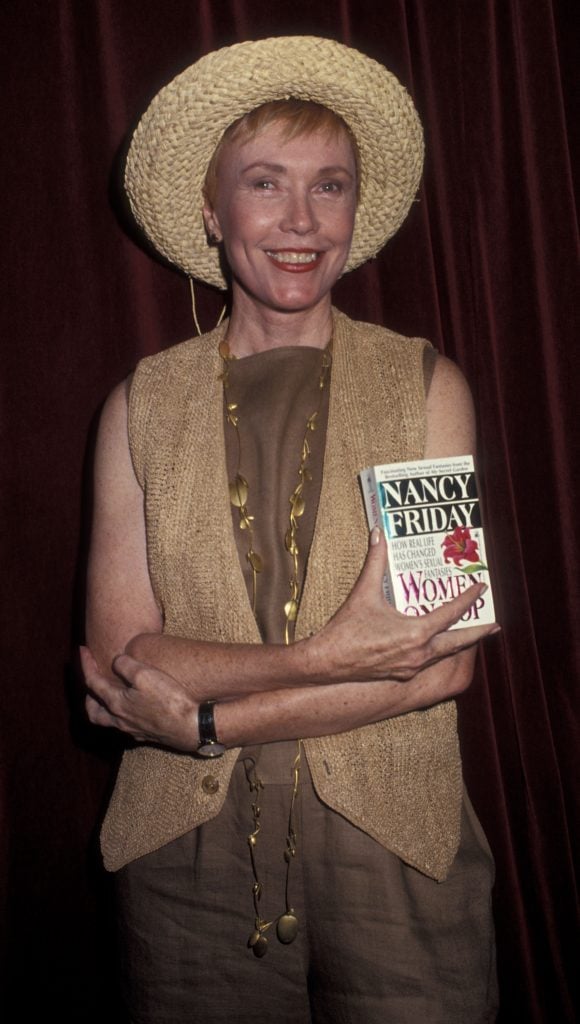Curiosities
Why Is Neil Gaiman Razzing MoMA? What Could DAOs Do to Art? + Other Questions I Have About the Week’s Art News
Plus, can this billionaire have his Norman Foster penthouse or what?

Plus, can this billionaire have his Norman Foster penthouse or what?

Ben Davis

Curiosities is a column where I comment on the art news of the week, sometimes about stories that were too small or strange to make the cut, sometimes just giving my thoughts on the highs and lows.
Below, some questions posed by the events of the last week…
It’s hard to say who’s the more famous to the general public: Roy Lichtenstein, everyone’s second guess when asked to name a famous Pop artist, or Neil Gaiman, the sci-fi and fantasy writer whose beloved 1989 comic series Sandman is currently giving fans the jitters as an adaptation finally makes its way towards manifestation.
In any case, Gaiman cast a curse at MoMA this week, evidently provoked by reading the label for Lichtenstein’s Drowning Girl, and noting its failure to mention Tony Abruzzo, who drew the image that inspired it:
Crediting the publisher and not the artist contributes to the fiction that these comics were created by companies and not by people, and that nobody drew the original images.
— Neil Gaiman (@neilhimself) November 13, 2021
In the unkindest cut of all for the scholarly institution, Gaiman followed up with a Tweet saying that MoMA actually bungled the name of Lichtenstein’s source material: “while you credit Secret Love #83, the comic was called Secret Hearts.”
This is not a new gripe in the comics art world. Lichtenstein’s comic-book appropriations have long irritated fans of their source materials.
Legendary Watchmen artist Dave Gibbons has called Lichtenstein a “copycat.” One parody once branded Lichtenstein—in what you will have to believe is a sick burn in the comics universe—“The Rich Man’s Vince Colletta.” I even see that Artnet News was called out for not mentioning the artist who inspired The Ring (Engagement)—that would be Ted Galindo—when the Lichtenstein canvas based on it sold at Sotheby’s in 2015.

Pop artist Roy Lichtenstein in his New York studio in 1968. (Photo by Jack Mitchell/Getty Images)
Here’s a funny story that gets passed around: Irv Novick, another comics artists whose art made its way into a signature Lichtenstein canvas (Whaam!, from 1963), actually happened to be the Pop painter’s superior officer when he was at boot camp during World War II. Novick’s account may be an embellishment, but you still get the sense of no love lost coming through in his telling of their 1947 meeting (as told in Mike Richardson and Steve Duin’s Comics: Between the Panels):
[Novick] had one curious encounter at camp. He dropped by the chief of staff’s quarters one night and found a young soldier sitting on a bunk, crying like a baby. “He said he was an artist,” Novick remembered, “and he had to do menial work, like cleaning up the officers’ quarters.
“It turned out to be Roy Lichtenstein. The work he showed me was rather poor and academic.” Feeling sorry for the kid, Novick got on the horn and got him a better job. “Later on, one of the first things he started copying was my work. He didn’t come into his own, doing things that were worthwhile, until he started doing things that were less academic than that. He was just making large copies of the cartoons I had drawn and painting them.”
For decades, Fantastic Four and Incredible Hulk artist Jack Kirby was held up example of an artist robbed of both artistic credit and ownership of his original drawings by the Marvel/Stan Lee juggernaut, which tended to treat its writers, pencilers, and so on as interchangeable cogs in the machine, not artists. As Bart Beaty writes in the essay “Roy Lichtenstein’s Tears: Art vs. Pop in American Culture,” “The fight for the return of Kirby’s art played a key role in the shaping of comic book fan resentment of figures such as Roy Lichtenstein.”

Roy LIchtenstein’s Drowning Girl on view at MoMA. Photo by Ben Davis.
The new Marvel movie Eternals is actually the first of the blockbuster cycle to credit Jack Kirby solo as its inspiration—a fact that has won an otherwise leaden entry into the Marvel movie canon some goodwill from fans, who are going all misty-eyed at seeing King Kirby get his due. In other words, MoMA is now playing catch-up to the Walt Disney Corporation on scoring corporate goodwill off of retroactive crediting for overlooked creators. Maybe we can bring Lichtenstein’s “secret love” out into the open?

The first printing of the final text of the United States Constitution on display during a press preview at Sotheby’s New York on September 17, 2021. Photo: Alexi Rosenfeld/Getty Images.
In one of the more perplexing auction decisions—or maybe just another example that all auction house categories are slowly collapsing into a big “whatever works” morass—Sotheby’s will offer one of the few historic copies of the U.S. Constitution during its contemporary art-themed “marquee auctions” this Thursday (somewhere between works by Banksy, Basquiat, and, as it so happens, Roy Lichtenstein).
The decision to treat this centuries-old piece of paper as a contemporary commodity is quirky. The best justification seems to come from Sotheby’s Brooke Lampley, who explained to the WSJ of the Constitution, “It is contemporary.” That’s either a bold statement of faith in the Founders’ vision or a less-bold assertion that the document does, in fact, currently exist.
The move drew immediate dividends, in any event. For what could be more contemporary than a cryptocurrency scheme immediately sprung up to buy the U.S. Constitution?
I speak of ConstitutionDAO, a so-called Decentralized Autonomous Organization that has formed to use the magic of smart contracts to pool funds from the public to raise $20 million to meet the high estimate for the Constitution at Sotheby’s.

Screenshot of the ConstitutionDAO website showing funds raised so far to buy the Constitution.
Since it was launched last Thursday, the crowdsourced bidding initiative has been picking up major press and a thundering head of steam, leaping from $6 million to $13 million overnight. Those behind ConstitutionDAO have seen how a big auction sale propagandized NFTs to the masses, and they hope to do the same for the idea of decentralized financial pools with a big move at Sotheby’s:
When Beeple sold his Everydays NFT at Christie’s for $69 million in March, it lit the NFT world on fire and kicked off the explosion in the growth of NFTs that we’re still experiencing today.
I think that if we win the Constitution, if We the People can come together and outbid institutions and the wealthiest collectors that normally win these things, it will set off a similar chain reaction in DAOs. The world will be watching, and this auction will be proof that DAOs can come together, responsibly and passionately, to collectively own everything from historical artifacts to art to real estate to physical collectibles. Hell, DAOs might start acquiring and decentralizing entire companies. (Maybe my dream of forming a DAO to buy Twitter will come true.)
According to the rules of the scheme, if you chip in you will get something called $PEOPLE tokens that allow you to vote on where the copy of the Constitution will be shown and what is done with it. (Just how all the finer points work remains a little hazy to me—but I guess that’s in the great tradition of American democracy.)
The team behind ConstitutionDAO states in a FAQ that, should they win, the community so far favors lending it to a free, public-minded institution, one “willing to cover the costs associated with housing the document.” So basically, they are hoping to get it and give it away before they have to deal with any of the finer points of owning and caring for a rare and valuable historical artifact.
There’s real GameStop-ish idealism here. And, I mean, letting the internet vote—what could go wrong? The Constitution could end up freed from the clutches of Sotheby’s ordinary class of Americana-loving moguls and sent to the Smithsonian or the New York Public Library (both of which have been contacted).
But it’s even odds that it ends up being shown in the hold of Boaty McBoatface.
He’s a finance guy who famously raked in billions of dollars of profit off of the crash of the world economy during Covid. She’s a superstar MIT design thinker pioneering living architecture who had to apologize to her students for concealing that her funding came from registered sex offender Jeffrey Epstein. Together, they have recently made the news by offering their un-asked-for support of Kenosha gunman Kyle Rittenhouse.

Bill Ackman and Neri Oxman attend the New York Stem Cell Foundation Gala and Science Fair at New York’s Jazz at Lincoln Center on October 7, 2019. Photo: Sean Zanni/Patrick McMullan via Getty Images.
I speak, of course, of New York power couple Bill Ackman and Neri Oxman, who are also in the news because they really, really want to have Norman Foster transform their Upper West Side penthouse into a deluxe family playpen. Irate neighbors who have opposed the design have decried it as looking like a “flying saucer” parked above the Museum of Natural History.
In reality, it just looks like one Mies van der Rohe glass house stacked upon another, larger Mies van der Rohe glass house. It lacks either Foster’s or Oxman’s sci-fi touch—that is, the design looks neither like a dock for a spaceship nor like it was injected with alien fungus.
Ackman, who has been embroiled in what the Guardian calls “a years-long public relations battle with his merely millionaire neighbours,” vows that his proposed Foster-designed perch will be architecturally restrained—respectful, even. Architecture critic Paul Goldberger has come out in favor of the design, even as one of the couple’s neighbors told New York’s Landmarks Preservation Commission that the penthouse “looks like a Malibu beach house that got blown onto our roof.”
(The commission yesterday declined to approve the project, saying that Ackman and Oxman would have to trim the second floor. It scheduled another vote for an unspecified later date.)
In the end, the design might not be the central issue: Upper West Siders just don’t seem to want to look up at this gleaming glass citadel and be reminded of them looking down on them all the time. Go figure.

Nancy Friday attends the Virginia Graham press conference on July 27, 1993, at the Algonquin Hotel in New York. Photo: Ron Galella, Ltd./Ron Galella Collection via Getty Images.
For me though, the real shocker of this story is that the property in question at 6-16 West 77th Street was up until 2017 owned by Nancy Friday, a best-selling author who wrote about female sexual fantasies. With her handsome proceeds, Friday had, over the course of years, managed to merge four apartments to create her own dream home, in quirky pink stucco.
I mean, just think of it: There was a time when a humble non-billionaire writer could have a fabulous penthouse apartment in New York! I don’t know whether that is sci-fi or pure fantasy at this point…